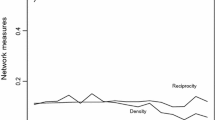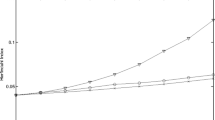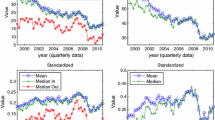Abstract
The topological properties of interbank networks have been discussed widely in the literature mainly because of their relevance for systemic risk. Here we propose to use the Stochastic Block Model to investigate and perform a model selection among several possible two block organizations of the network: these include bipartite, core-periphery, and modular structures. We apply our method to the e-MID interbank market in the period 2010–2014 and we show that in normal conditions the most likely network organization is a bipartite structure. In exceptional conditions, such as after LTRO, one of the most important unconventional measures by ECB at the beginning of 2012, the most likely structure becomes a random one and only in 2014 the e-MID market went back to a normal bipartite organization. By investigating the strategy of individual banks, we explore possible explanations and we show that the disappearance of many lending banks and the strategy switch of a very small set of banks from borrower to lender is likely at the origin of this structural change.





Similar content being viewed by others
Notes
“The ECB is ready to do whatever it takes to preserve the Euro. And believe me, it will be enough.”
Technically, when the inference gives a large block and a very small one (i.e. composed by less than 5% of the nodes, typically 2 or 3 banks), we shall consider it equivalent to a one block structure.
We have also performed extensive numerical simulations on the role of small sample size (e.g. number of banks) in the inference. By simulating a SBM with the inferred parameters and the same number of banks, we found that the inference method is able to identify very clearly the model even when the sample size is small (data available upon request).
It is also worth mentioning that most algorithms on networks, including inference of SBM and other centrality metrics, as for instance eigenvector centrality, are highly dependent on degree-heterogeneity. If not properly taken into account (Karrer and Newman 2011; Peixoto 2012; Barucca and Lillo 2016), this heterogeneity affects structure inference. In fact a core-periphery structure may be found where the highest degree nodes are put in the core and lowest degree nodes are put in the periphery without the core being more densely connected than the periphery.
We choose to investigate the binary network because we want to disentangle the change of strategy due to in- and out-degree from the one due to a global variation of the amount of exchanged money.
References
Amini H, Cont R, Minca A (2012) Stress testing the resilience of financial networks. Shape Int J Theor Appl Financ 15:1250006
Baba T et al (2006) Construction of Escherichia coli K-12 in-frame, single-gene knockout mutants: the Keio collection. Mol Syst Biol. doi:10.1038/msb4100050
Bargigli L, di Iasio G, Infante L, Lillo F, Pierobon F (2015) The multiplex structure of interbank networks. Quant Financ 15:673–691
Barucca P, Lillo F (2016) Disentangling bipartite and core-periphery structure in financial networks. Chaos Solitons Fractals 88:244–253
Borgatti SP, Everett MG (2000) Models of core/periphery structures. Soc Netw 21(4):375–395
Boss M, Elsinger H, Summer M, Thurner S (2004) Network topology of the interbank market. Shape Quant Financ 4:677–684
Boyd JP, Fitzgerald WJ, Beck RJ (2006) Computing core/periphery structures and permutation tests for social relations data. Soc Netw 28(2):165–178
Cont R, Moussa A, Santos EB (2012) Network structure and systemic risk in banking systems. In: Fouque JP, Langsam J (eds) Shape handbook of systemic risk. Cambridge University Press, Cambridge
Craig B, Von Peter G (2014) Interbank tiering and money center banks. J Financ Int 23(3):322–347
Decelle A, Krzakala F, Moore C, Zdeborová L (2011) Asymptotic analysis of the stochastic block model for modular networks and its algorithmic applications. Phys Rev E 84:066106
Erdös P, Rényi A (1960) On the evolution of random graphs. Publ Math Inst Hung Acad Sci 5:17
Finger K, Fricke D, Lux T (2013) Network analysis of the e-MID overnight money market: the informational value of different aggregation levels for intrinsic dynamic processes. Comput Manag Sci 10:187–211
Fricke D, Lux T (2015) Core-periphery structure in the overnight money market: evidence from the e-MID trading platform. Comput Econ 45(3):359–395
Fricke D, Finger K, Lux T (2013) On assortative and disassortative mixing in scale-free networks: the case of interbank credit networks. Kiel Working Paper, No. 1830
Gabrieli S, George C-P (2014) A network view on interbank market freezes. Deutsche Bundesbank discussion paper No 44/2014
Hatzopoulos V, Iori G, Mantegna RN, Micciché S, Tumminello M (2015) Quantifying preferential trading in the e-MID interbank market. Quant Financ 15:693–710
Holme P (2005) Core-periphery organization of complex networks. Phys Rev E 72:046111
in ’t Veld D, van Lelyveld I (2014) Finding the core: network structure in interbank markets. J Bank Financ 49:27–40
Iori G, Jafarey S, Padilla FG (2006) Systemic risk on the interbank market. J Econ Behav Org 61:525–542
Iori G, De Masi G, Precup OV, Gabbi G, Caldarelli G (2008) A network analysis of the Italian overnight money market. shape. J Econ Dyn Control 32:259–278
Iori G, Mantegna RN, Marotta L, Micciché S, Porter J, Tumminello M (2015) Networked relationships in the e-MID Interbank market: a trading model with memory. J Econ Dyn Control 50:98–116
Kapar B, Iori G, Olmo J (2015) Bank characteristics and the interbank money market: a distributional approach. Stud Nonlinear Dyn Econom 19:249283
Karrer B, Newman MEJ (2011) Stochastic blockmodels and community structure in networks. Phys Rev E 83:016107
Lip SZW (2011) A fast algorithm for the discrete core/periphery bipartitioning problem. arXiv preprint arXiv:1102.5511
Peixoto TP (2012) Entropy of stochastic blockmodel ensembles. Phys Rev E 85:056122
Peixoto TP (2013) Parsimonious module inference in large networks. Phys Rev Lett 110:148701
Peixoto TP (2014) Efficient Monte Carlo and greedy heuristic for the inference of stochastic block models. Phys Rev E 89:012804
Rombach MP, Porter MA, Fowler JH, Mucha PJ (2014) Core-periphery structure in networks. SIAM J Appl Math 74:167–190
Temizsoy A, Iori G, Montes-Rojas G (2015) The role of bank relationships in the interbank market. J Econ Dyn Control 59:118–141
Zhang X, Martin T, Newman MEJ (2015) Identification of core-periphery structure in networks. Phys Rev E 91:032803
Acknowledgements
Authors acknowledge partial support by the grant SNS13LILLB ”Systemic risk in financial markets across time scales”. This work is supported by the European Communitys H2020 Program under the scheme INFRAIA-1-2014-2015: Research Infrastructures, grant agreement #654024 SoBigData: Social Mining and Big Data Ecosystem (http://www.sobigdata.eu). Authors also thanks Fabio Caccioli, Thomas Lux, and Daniele Tantari for useful discussions.
Author information
Authors and Affiliations
Corresponding author
Appendix: Algorithms for core-periphery detection
Appendix: Algorithms for core-periphery detection
In the literature the analysis is conducted basically assuming a core-periphery structure for the network and the following different models are used:
-
The discrete model (Fricke and Lux 2015). It involves the minimization of a cost-function associated to each discrete assignment of the nodes. Each link between nodes inside the core lowers the cost-function while each link between nodes inside the periphery raises it, no contribution comes from the links between core nodes and periphery nodes. It has been shown (Lip 2011) that this minimization is equivalent to sort nodes in the graph by descending degree, (\(k_1>k_2>\cdots >k_N\)) and consider the first s nodes, where s is such that \(k_s > s+1\). Being dependent on the average degree and not on its directionality, this method is insensitive to directed bipartite structures, where there is large directed flow from one group of nodes to another, since nodes with high out-degree and nodes with high in-degree end up inside the core.
-
The symmetric continuous model (Fricke and Lux 2015). It involves the minimization of a different cost-function namely:
$$\begin{aligned} \varvec{u}=\underset{u}{{\text {argmin}}}\ H_{B}[u]=\underset{u}{{\text {argmin}}}\sum _{i\ne j}(A_{ij}-u_{i}u_{j})^{2} \end{aligned}$$(5)Also in this case the symmetry of this coreness measure does not help to understand whether the underlying network has a bipartite structure or a core-periphery structure.
-
The asymmetric continuous model (Fricke and Lux 2015). It involves the minimization of a cost-function that distinguishes between an in-coreness and an out-coreness
$$\begin{aligned} \varvec{u}=\underset{u,v}{{\text {argmin}}}\ H_{B}[u]=\underset{u}{{\text {argmin}}}\sum _{i\ne j}(A_{ij}-u_{i}v_{j})^{2} \end{aligned}$$(6)This model, as shown in Fricke and Lux (2015), catches the directed structure of the network and indeed significant differences are found between out-coreness and in-coreness. This is a clear indication that a community structure more suitable to grasp the properties of e-MID interbank market is most probably a bipartite one.
-
The tiering model (Craig and Peter 2014). It can be regarded as an extension of the discrete model, incorporating the role of asymmetric links and of inter-group links. The basic idea is that a core-node should have both a non-zero in- and out-degree. It relies on a tiering model for banks in a market, the core is a set of intermediary banks that both borrow and lend money to periphery banks.
All these methods, especially the directed ones, manage to grasp some of the properties of the e-MID interbank network but a major drawback is that they fix a-priori the block-structure one is supposed to find in the data. In our work we use a well-established model for community detection, the Stochastic Block Model, that allows us to extrapolate the block structure from the data only, without imposing constraints on the mutual relations between groups. As we outline in the text, at all levels of aggregation the unweighted network of e-MID market exhibits a directed bipartite structure, also confirmed by a detailed enquiry of the dynamics of the trading inventory of banks.
Rights and permissions
About this article
Cite this article
Barucca, P., Lillo, F. The organization of the interbank network and how ECB unconventional measures affected the e-MID overnight market. Comput Manag Sci 15, 33–53 (2018). https://doi.org/10.1007/s10287-017-0293-6
Received:
Accepted:
Published:
Issue Date:
DOI: https://doi.org/10.1007/s10287-017-0293-6




